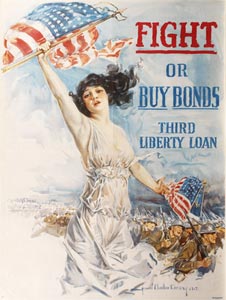
Norman Rockwell Museum
November 8, 2008 through January 25, 2009
Huntsville Museum of Art, Alabama
July 23, 2016 through October 15, 2016
Upcountry History Museum Furman University, Greenville, SC
June 17, 2017 – September 10, 2017
When America entered World War I, it was clear that engagement in the conflict would require sustained effort of a magnitude and intensity that had previously been unimagined. Ready troops, supplies, and sacrifice on the home front were necessities, and the resolve of American citizens was essential—a powerful message brought home to the public through the visual arts.
During World War I, illustrated posters inspiring public support served as a primary mechanism of mass communication. Persuasive visual symbols designed to rally Americans to the cause, they employed bold graphics, strong imagery, and concise commands to inspire a sense of nationalism and pride. Posters roused people to support their troops, fund international aid projects, and buy bonds to finance the war effort. Imbued with iconic United States symbols like the Statue of Liberty, Uncle Sam, and the American flag, posters were installed in libraries, post offices, and schools in urban and rural communities as prominent reminders of the need for support.
Eager to contribute their talents, artists who were not enlisted in the armed forces designed posters and billboards and offered public painting demonstrations to inspire the purchase of war bonds. Chaired by celebrated illustrator Charles Dana Gibson, the Committee on Public Information’s Division of Pictorial Publicity met regularly to connect artists with projects. The dynamic imagery that resulted, created by an impressive roster of illustrators including J.C. Leyendecker, James Montgomery Flagg, Howard Chandler Christy, and Jessie Willcox Smith among others, offers compelling perspectives on the American experience during this dramatic time in our nation’s history.

